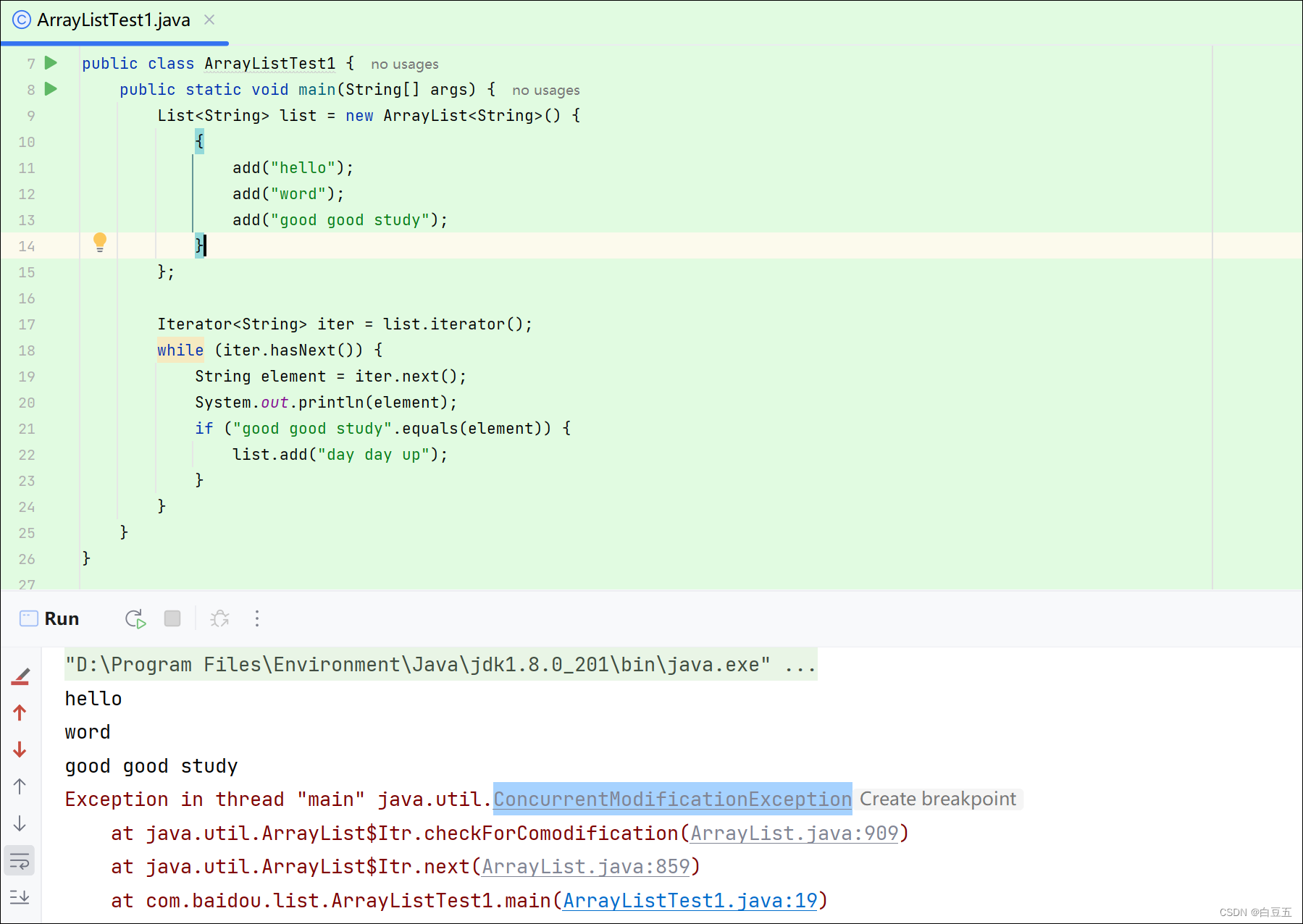一、ArrayList集合源码
1、ArrayList的特点
- 数据结构:基于数组实现,类型:object类型;
- 存放元素:有序,可重复;
- 线程是否安全:不安全,效率高。(没有加上锁机制)
- 特点:查询快、增删慢;
- 查询快:因为ArrayList底层是基于动态数组实现的,所存储的数据在内存中是连续的,可以通过下标获取元素,即get(index)方法,时间复杂度为O(1);
- 增删慢: 数组长度是不可改变,需要频繁创建新数组,拷贝元素,销毁老数组(扩容、缩容)。
Vector的特点:
- 底层基于数组实现的;
- 查询快、增上慢;
- 线程同步,安全,效率低。
2、时间复杂度
- O(1):只需查询一次就能找到元素,例如:get(index)方法,基于下标查询;
- O(n):需要从头查到尾部,例如:根据元素值查询;(如 链表)
- O(log n):二叉树、红黑树。
3、add方法与扩容机制
3.1 add方法实现
package com.baidou.list;
public class MyArrayList<T> {
/**
* 存放元素的数组
*/
Object[] elementData;
/**
* elementData 存放元素的个数
*/
private int size;
/**
* elementData 默认初始容量为10
*/
private static final int DEFAULT_CAPACITY = 10;
/**
* 无参构造器
*/
public MyArrayList() {
}
/**
* 新增元素
*
* @param t 元素
*/
public void add(T t) {
// 默认的初始化
if (elementData == null) {
// 如果创建ArrayList集合时没有指定大小,默认初始长度为10
elementData = new Object[DEFAULT_CAPACITY]; // CAPACITY:10
}
elementData[size++] = t;
}
/**
* 获取元素
*
* @param index
* @return
*/
public T get(int index) {
return (T) elementData[index];
}
public static void main(String[] args) {
MyArrayList<String> arr = new MyArrayList<String>() {
{
add("Hello");
add("world");
}
};
String arr_Index0_Value = arr.get(0);
System.out.println(arr_Index0_Value);
}
}
3.2 扩容机制
扩容:ArrayList每次扩容是原来的1.5倍。
1、源码分析:
- 调用链条:add()—>ensureCapacityInternal()—>calculateCapacity()—>ensureExplicitCapacity(?)—>grow()
public void add(int index, E element) {
rangeCheckForAdd(index);
ensureCapacityInternal(size + 1); // Increments modCount!!
System.arraycopy(elementData, index, elementData, index + 1,
size - index);
elementData[index] = element;
size++;
}
// 模拟ArrayList存放第11个元素场景
private void grow(int minCapacity) {
//11
// 原来容量 10
int oldCapacity = elementData.length;
// 新的容量 10+(10/2)=15
int newCapacity = oldCapacity + (oldCapacity >> 1);
if (newCapacity - minCapacity < 0) newCapacity = minCapacity; //false
// 新的容器是否超过这个数值界限
if (newCapacity - MAX_ARRAY_SIZE > 0) newCapacity = hugeCapacity(minCapacity); //fase
// 扩容
// 拷贝数组,数组长度为15
elementData = Arrays.copyOf(elementData, newCapacity);
}
2、add方法,扩容原理实现:
public void add(T t) {
// 默认的初始化
if (elementData == null) {
// 如果创建ArrayList集合时没有指定大小,默认长度为10
elementData = new Object[DEFAULT_CAPACITY]; // CAPACITY:10
}
// 判断是否需要做扩容
if (size + 1 > elementData.length) {
// 原来容量
int oldCapacity = elementData.length;
// 新的容量
int newCapacity = oldCapacity + (oldCapacity >> 1);
// 扩容
elementData = Arrays.copyOf(elementData,newCapacity);
}
elementData[size++] = t;
}
4、remove方法与缩容机制
1、源码分析:
//根据元素内容删,时间复杂度为O(n)
public boolean remove(Object o) {
if (o == null) {
for (int index = 0; index < size; index++)
if (elementData[index] == null) {
fastRemove(index);
return true;
}
} else {
for (int index = 0; index < size; index++)
if (o.equals(elementData[index])) {
fastRemove(index);
return true;
}
}
return false;
}
//缩容方法
private void fastRemove(int index) {
modCount++; //因为arraylist是非线程安全,需要记录增删操作
// 模拟集合容量为15,元素个数为11,删除第十个元素
// 计算删除index后面的元素有多少个
//11-9-1=1;
int numMoved = size - index - 1;
if (numMoved > 0)
// index后面的元素要向前移动1位
System.arraycopy(elementData, index+1, elementData, index,numMoved);
elementData[--size] = null; // 把最后一个元素变为null
}
2、remove方法,缩容原理实现:
// 根据内容删除元素
public boolean remove(T t) {
if (t == null) {
// 如果删除元素内容为null,也需要进行遍历删除
for (int index = 0; index < size; index++) {
if (elementData[index] == null) {
fastRemove(index);
return true;
}
}
} else {
for (int index = 0; index < size; index++) {
if (t.equals(elementData[index])) {
fastRemove(index);
return true;
}
}
}
return false;
}
/**
* 缩容实现
*
* @param index 删除元素的索引
*/
private void fastRemove(int index) {
// 计算删除index后面的元素有多少个
int numMoved = size - index - 1;
if (numMoved > 0) {
// 把index后面的元素往前移动1位
System.arraycopy(elementData, index + 1, elementData, index, numMoved);
}
elementData[--size] = null; // 把最后一个元素变为null
}
5、modCount的作用
modCount:记录当前集合被修改的次数。 新增和删除modCount会++
例如:在多线程的情况下,A线程去遍历集合,B线程去存放数据,会抛出并发修改异常。
@Override
public void forEach(Consumer<? super E> action) {
Objects.requireNonNull(action);
final int expectedModCount = modCount;
@SuppressWarnings("unchecked")
final E[] elementData = (E[]) this.elementData;
final int size = this.size;
for (int i=0; modCount == expectedModCount && i < size; i++) {
action.accept(elementData[i]);
}
// 如果当前的modCount和预期count值不一致时,会抛并发修改异常
if (modCount != expectedModCount) {
throw new ConcurrentModificationException();
}
}
